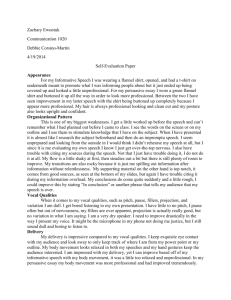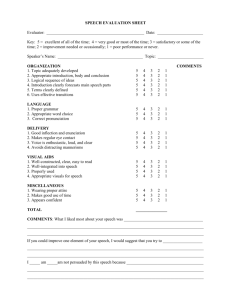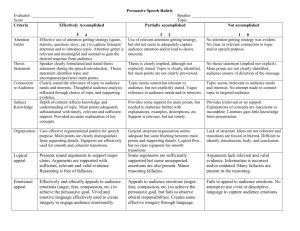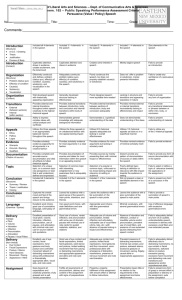DEMONSTRATION SPEECH Oral Communications
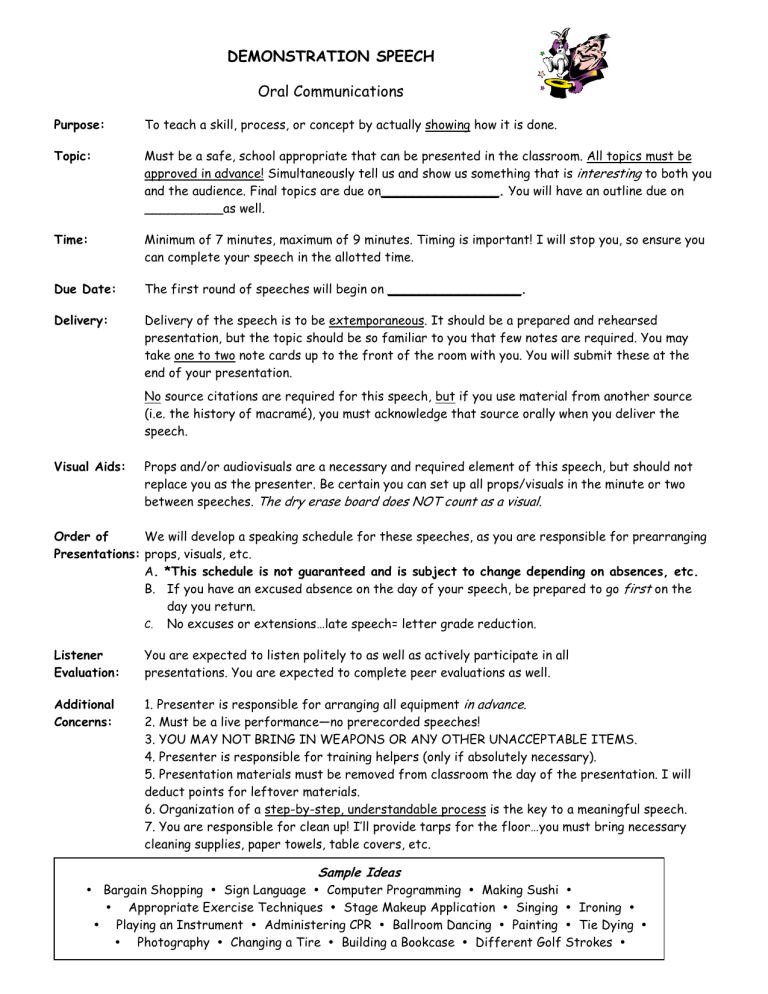
DEMONSTRATION SPEECH
Oral Communications
To teach a skill, process, or concept by actually showing how it is done.
Purpose:
Topic: Must be a safe, school appropriate that can be presented in the classroom. All topics must be approved in advance! Simultaneously tell us and show us something that is
interesting
to both you and the audience. Final topics are due on _______________.
You will have an outline due on
__________as well.
Time: Minimum of 7 minutes, maximum of 9 minutes. Timing is important! I will stop you, so ensure you can complete your speech in the allotted time.
Due Date:
Delivery:
The first round of speeches will begin on _________________.
Delivery of the speech is to be extemporaneous. It should be a prepared and rehearsed presentation, but the topic should be so familiar to you that few notes are required. You may take one to two note cards up to the front of the room with you. You will submit these at the end of your presentation.
No source citations are required for this speech, but if you use material from another source
(i.e. the history of macramé), you must acknowledge that source orally when you deliver the speech.
Visual Aids: Props and/or audiovisuals are a necessary and required element of this speech, but should not replace you as the presenter. Be certain you can set up all props/visuals in the minute or two between speeches.
The dry erase board does NOT count as a visual.
Order of We will develop a speaking schedule for these speeches, as you are responsible for prearranging
Presentations: props, visuals, etc.
C.
day you return.
No excuses or extensions…late speech= letter grade reduction.
Listener You are expected to listen politely to as well as actively participate in all
Evaluation: presentations. You are expected to complete peer evaluations as well.
Additional
Concerns:
A . *This schedule is not guaranteed and is subject to change depending on absences, etc.
B.
If you have an excused absence on the day of your speech, be prepared to go
first
on the
1. Presenter is responsible for arranging all equipment
in advance.
2. Must be a live performance—no prerecorded speeches!
3. YOU MAY NOT BRING IN WEAPONS OR ANY OTHER UNACCEPTABLE ITEMS.
4. Presenter is responsible for training helpers (only if absolutely necessary).
5. Presentation materials must be removed from classroom the day of the presentation. I will deduct points for leftover materials.
6. Organization of a step-by-step, understandable process is the key to a meaningful speech.
7. You are responsible for clean up! I’ll provide tarps for the floor…you must bring necessary cleaning supplies, paper towels, table covers, etc.
Sample Ideas
Bargain Shopping Sign Language Computer Programming Making Sushi
Appropriate Exercise Techniques Stage Makeup Application Singing Ironing
Playing an Instrument Administering CPR Ballroom Dancing Painting Tie Dying
Photography Changing a Tire Building a Bookcase Different Golf Strokes
Name _______________ Bell _____ Speech Topic _______________
Rubric for the Demonstration Speech
A: 76-85 pts. B: 68-75 pts. C: 59-67 pts. D: 51-58 F: 50 &
Demonstration speeches will be graded on the following criteria:
A.
Content: Offers insight and originality in topic/ideas; presents a solid, effective introduction and conclusion; establishes ethos; adapts topic/information to audience; avoids jargon and defines unclear terms or concepts; offers clear direction and step-bystep organization throughout; appropriate for classroom setting.
Delivery: Maintains eye contact with entire audience throughout the speech; remains poised yet relaxed; conveys message through facial expression and vocal variation; remains conversational with few vocal pauses and/or fillers; maintains an appropriate pace; simultaneously and effectively demonstrates skill while talking; aware of time expectations; *involves audience and/or volunteers in an efficient and useful manner.
Visual Aids: Attractive and highly visual; managed appropriately throughout speech; serve as a necessary and beneficial element of speech.
B.
Content: Maintains some sense of originality while remaining unified around a central idea; presents a competent introduction and conclusion; defines most unclear terms and concepts; attempts to establish ethos; relates ides/concepts to audience at some point in speech; reflects a proficiency in language usage and style; usually offers clear direction and step-by-step organization.
Delivery: Maintains eye contact with some audience members during speech; remains poised; uses facial expression and vocal variation; adequate volume and enunciation, usually maintains an appropriate pace; remains somewhat conversational with a few, non-distracting vocal pauses and/or fillers; aware of time expectations; usually demonstrates skill while talking; *audience participation and/or volunteer use is somewhat beneficial and managed effectively.
Visual Aids: Mostly attractive and easy to see; usually managed appropriately; serve as a beneficial element of speech.
C.
Content: Addresses the overall topic but includes unrelated and/or insignificant material; may have undeveloped introduction and/or conclusion; attempts to follow an organizational pattern, but fails to maintain clarity and completeness; offers little attempt to adapt ideas/concepts to audience; attempts to establish ethos, but fails to maintain credibility; directions may be unclear with no apparent pattern of organization.
Delivery: Attempts to establish eye contact with some audience members, but relies on note cards/visual; includes distracting movement; may use minimal facial expression and voice may be somewhat monotone; volume and / or enunciation need work, may speak at an awkward pace; may include distracting vocal pauses and/or fillers; rarely offers direction to audience while demonstrating skill; may appear unaware of time requirement; effectiveness of overall message may be inhibited by delivery; *may include unnecessary and/or mismanaged audience participation.
Visual Aids: May be difficult to see and somewhat unprofessional; may be used inappropriately and/or ineffectively; may be distracting to and/or unnecessary for speech.
D.
Content: May offer underdeveloped introduction and conclusion; uses elementary ideas and themes; offers little attempt to adapt material to audience; fails to establish ethos; uses vague directions with little development; exhibits poor overall organization and little detail.
Delivery: Relies on note cards/visuals, and fails to establish eye contact; includes distracting movement; speaks at an awkward pace with little to no enthusiasm; inadequate volume and/or enunciation, includes distracting vocal pauses and/or fillers; fails to meet time requirement; fails to speak to audience while demonstrating skill; delivery reveals little to no preparation.
Visual Aid: May be illegible and/or unprofessional with little to no evidence of creativity; distracting and/or unrelated to speech topic; not used effectively.
ADDITIONAL COMMENTS:
Outline Score
•
____/5
•
____/5
•
____/5
•
____/15
Outline includes a complete introduction and conclusion
Outline includes detailed main ideas/sub points
Outline is in correct format (typed, outline format, etc.)
TOTAL POINTS EARNED

